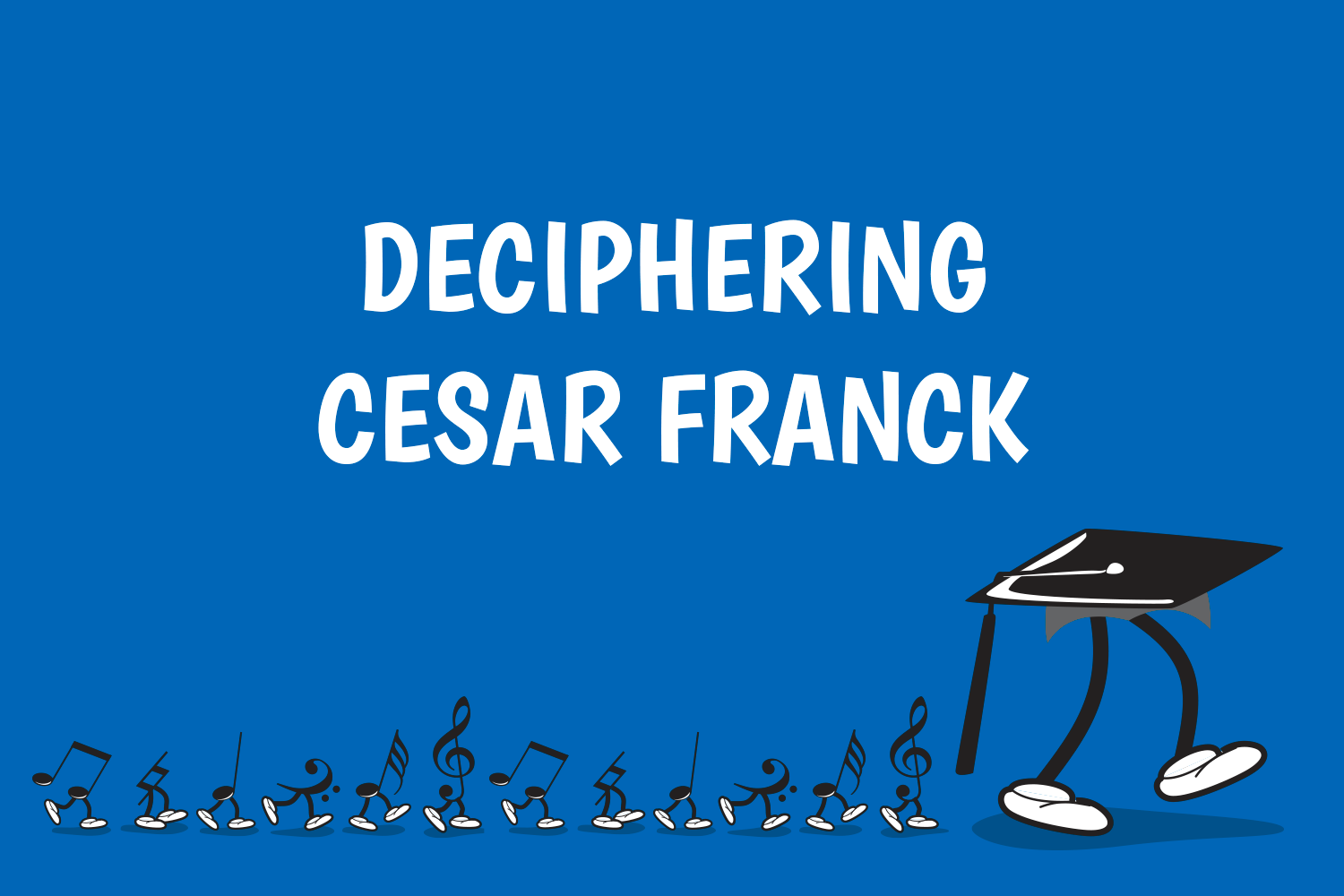Deciphering Cesar Franck

This post originally appeared on our PreachWhatYouPractice site.
Original Published Date: 27 August 2013
A couple of months ago I was asked to accompany a friend in a recital. My new-found excitement in going back to practice caused me to say yes, and amongst the music I was given was Cesar Franck’s Violin Sonata in A major. I was warned by the violinist that the accompaniment is ‘somewhat challenging’.
This turned out to be inaccurate. I would substitute ‘somewhat’ for a decidedly stronger adjective, one that I cannot write here. Suffice it to say I think it is really a piano concerto with violin accompaniment.
I began the slow process of learning the first and second movements. I had only committed to these two movements because the performance deadline was September 12, a mere 12 weeks away. It was to be a 40-minute recital at an aged care facility, which always provides the most appreciate of audiences 1.The program would consist mostly of crowd-pleaser violin pieces such as Czardas, Hungarian Rhapsody and Meditation, and would finish with the Franck. So most of the recital would involve oom-cha oom-cha from me while the violinist performs huge virtuosic feats… and then in the Franck, the tables are most definitely turned 2.
I gave myself a deadline of being able to play this accompaniment note-perfect and up to speed by August 12, a month before the performance date. This would give me 31 days to devote to fine-tuning everything in rehearsals with the soloist. Eight weeks to learn an accompaniment? Easy peasy!
Not so easy peasy. I have never read such an unsightreadable accompaniment. Pretty much every phrase had to be deciphered in some way: from complicated accidentals to inner melody lines to compensating with one hand or the other for the impossibly large chords (Cesar Franck’s hand span was seriously huge, and he didn’t stop to consider that the average person’s was not).
I thought to myself: I will never, EVER be able to play this up to speed. I could barely play accurately separate hands. I actually cried during some practices, when my fingers just would not, could not do it.
I persevered, the weight of commitment heavy on my heart. I forced myself to go straight to the ‘hot-spots’ as a pianist friend of mine calls them: the parts I was having real trouble with. (This takes more willpower than one would think; I can totally see why my students don’t do it. It’s so easy to think “I’ll just play from the beginning and when I get to that hard part I’ll stop and practice it”. This wastes a lot of time and more often than not the hot-spot doesn’t actually get practised at all.)
Despite needing to watch the score carefully because of the intricate writing, I found that there were some passages that just would not work unless I looked down at my fingers. For example, a fast semiquaver passage ending with the two notes A double-sharp – B sharp… this is really just B-C. Much easier when you think of it like that. I wrote ‘B-C’ above the notes on the score, but in the end it was better not looking at the score. Same with many of the huge leaps, which really need some major eyeballing in order to be accurate every single time. No-one expects you to play blindfolded… so there’s no sense in keeping your eyes glued to the page when you’re aiming for a note 2.5 octaves away from the one you’re currently playing.
The problem with memorising some passages and not all is that I would kind of lose my place when it was time to look up at the music again. It took only a split second to find the right spot but even this tiny glitch was enough to interrupt the flow of the music. So if the flow could be interrupted during practice at home, imagine what would happen during the performance? I am experienced enough to know that any tiny mishap in the practice room is magnified a hundredfold on the stage.
So the half-memorising-half-reading thing has proved to be a challenge. I have had to really practice where I’m looking and at what stages. I would probably prefer to memorise the whole piece but it is not really an option to play an accompaniment from memory, primarily because this leaves no safety net should anything go slightly awry with the soloist’s part (or, the horror of horrors, my part).
Once I had the notes in hand (pun absolutely intended) and knew which passages I was ‘reading’ and which I was memorising, I employed all the usual practice techniques including playing in rhythms, playing with accents, exaggerated finger movements, gradually increasing the speed using the metronome. Slowly (very slowly) but surely my fingers started to get the hang of it.
My teenage daughter, listening from another room, has commented many times over the past eight weeks ‘aren’t you totally sick of that?’ (grrr). That was actually one of her nicer comments. The others were more like ‘can’t you play that any faster yet?’ (more grrr) or ‘you keep making a mistake there’ (most grrrr). But then it so happened that she started learning Debussy’s ‘Girl with the Flaxen Hair’ etude in G flat major, which involves some ‘deciphering’ (especially for a teenager) because of the key signature and intricate fingering. She found some empathy for me. I found that the advice I gave her matched the strategy I was using for my own practice – that sometimes you have to bite the bullet and memorise a passage because it’s just too complicated to keep looking at the page.
Just the other day I finally managed to play the second movement (consisting mostly of semiquavers) at crotchet = 120, without tension and with expression and with pretty much all the right notes, and a big accelerando at the end! Applause rang out from the next room, where my daughter was on the digital piano with headphones on, trying to practice but unable to hear herself due to the volume of my playing.
Practice is an amazing thing. Muscles are amazing things. They can achieve great things if you keep trying. The phrase ‘never say never’ is really quite accurate!
- Performing for this demographic also eases the pressure on the violinist, whose mistakes in the higher registers might easily go unheard
- This is not to say that the violin part of the Cesar Franck is in any way the equivalent of ‘oom-cha oom-cha’ on the piano. But even my friend admits that it’s not particularly hard to play. Interestingly enough it has been transcribed for flute and is apparently very difficult, too difficult for my daughter to play just yet, so maybe we’ll wait a year or two. Lucky for me it is still in A major…

So enjoyed this! What an honest and relatable description. Thank you!
Oh dear. I was just searching the interwebs for a simplified piano arrangement. A dear young theory student of mine is performing this for her HSC music exam and I agreed to accompany her before I looked at the score. Well, time to put my sight reading / memorising / polishing skills to the test, right?
Good luck Rebecca!!!!
Thank you for the delightful and oh-so-relatable post! I’m working on the same sonata at the moment, and everything you said resonates, including the spot you referred to with the A double-sharp B sharp!
Did you make any textual changes for playability? I’d love to play everything as written, but may have to shift a few notes (such as an Eb and a D in the coda of the second movement, in case that rings a bell) in order to reach them at speed.
Hey Jim! Yes I absolutely made changes as necessary… can’t remember what they were, but I do this all the time. Playability is much more important than risking injury!
Thank you so much for this. I have reached my 82nd year on this earth before getting to this work and I don’t know yet whether it is rejuvenating or ageing me!
First movement okay now but the second movement…..might take me into my nineties!
But yes, your comments, so exactly matching my struggles, are really helpful and encouraging.
Please accept my huge thanks.
(Maybe I will take up the violin….sounds easier)
Derek Williams
Thank you for your really interesting comments…. eloquently reflecting my own experience. First movement okay after a few months work, but second really daunting (“super hard” I read on one website.)
But ALL EXCELLENT CURE FOR DUPUYTRENS CONTRACTURE victims!
Mine has recurred after operation but now being held firmly in check by night-time wearing of comfortable felt-covered splints (from Amazon, of course).
Franck sets a lovely challenge for modest-fingered Dupuytrens cases!!
Love it!
And thank you again, Samantha Coates.
Wow, good luck with the splints and the 2nd movement!!! 🙂